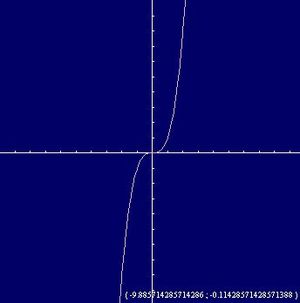Simplicity is a form of beauty. In mathematics, whenever a procedure can be simplified, it is considered elegant to do so. Once, in fact, the author had a professor of mathematics instructing a class on vector calculus. On a quiz, he had the correct answer, but took extra steps to arrive at the answer. He was penalized for the extra steps. Yes, simplicity is a form of beauty.
One way to simplify in mathematics is to take advantage of symmetry. What is symmetry? Rather than define it, let’s illustrate it. The human face possesses symmetry. As there is one ear on one side of the face, so there is an ear in the same spot on the other side of the face. So as far as the ears are concerned, the face is symmetrical. The eyes are symmetrically placed, also. In fact, if a line of symmetry is drawn down the center of the face, the two halves of the nose are symmetric, as are the two sides of the mouth, left and right.
Geometrical Symmetry about the X-Axis
Draw an x, y-coordinate system axes-pair. Now draw1 the parabola y = x2. Notice that the left branch of this parabolic curve has an equivalent branch on the other side of the y-axis. This is because if a certain value of x gives a value of y, putting a minus sign in front of the value for x gives the same value of y. To illustrate, if x = 2, y = 4. If x = -2, y still equals 4.
Geometrical Symmetry about the Y-Axis
Now draw the equation x = y2. It looks identical to the other equation, except it is tilted and appears to be symmetrical about the x-axis. In fact, it is. The equation x = y2 is symmetrical about the x-axis. This is because if given a positive value for y, a certain value of x results. If that same value of y is given a minus sign in front, it produces the same value of x.
Geometrical Symmetry about the Origin
The origin is the point (0, 0) in the x, y-coordinate system. There are equations that are symmetric about that point. The most obvious of these are circles with their center at the origin, for instance, x2+ y2 = r2.
Symmetry about a Point
There are other symmetries. For instance, the cubical parabola2, y = (x – 2)3 + 3 has symmetry3 about the point (2, 3). In the case of the circle, symmetry exists about any line in the plane of the circle that passes through its point of symmetry.
Symmetry Dimensionality
Symmetry about a point is considered 1-dimensional or 1-D. Symmetry about a line is 2-D. Symmetry about a plane (which requires the x, y, z-coordinate system or something comparable) is 3-D. If our circle about the origin was, instead, a sphere, then it would be symmetrical about any plane that passes through the origin.
In Our Next Discussion…
Next time, we will discuss rotational symmetry.
1 To recall how to do this, please see the first article of this series, Lesson 1: The “Coordinate Axes” Plus Drawing a Line.
2 To see the graph of a the cubic parabola y = x3, examine the image associated with this article.
3 The cubical parabola has other symmetries, also, which will be discussed in another article.







